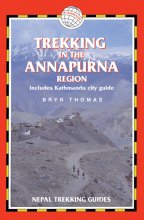Guides that will send you packing.
— Today

Trekking in the Annapurna Region
Excerpt:
When to go
Contents List | Introduction | With a group or independently? | When to go | Minimum impact trekking | Sample route

The Annapurna region is one of the few trekking areas in Nepal where year-round trekking is not only possible but also enjoyable. The northern part of the region receives little of the monsoon rain since it's shielded by the Annapurnas and other ranges.
Mountain-viewing is a prime reason for going trekking, so it's not surprising that the most popular trekking seasons correspond to when the Himalaya are at their clearest and most dramatic and the weather is neither too cold nor too wet. The number of visitors to the Annapurna region is highest in October and November and still quite high in the months of September, December, March and April. January, February and May see about a third of the number of tourists compared to March. June to August is the quietest time.
SEASONS
While Nepal has four seasons corresponding to the winter, spring, summer and autumn of Europe or North America, the pattern of rainfall is very different. About 70% of the total annual rainfall occurs in the monsoon season between June and September.
October and November
The post-monsoon season is the most popular time to go trekking. The atmosphere has been flushed clean by the rains leaving the mountains stunningly clear and the weather is still warm. Above 3000m/9843ft, however, the temperature will usually drop below freezing at night. The drawback is the fact that from October until the end of November the trails are very crowded and lodges fill up early in the afternoon.
December to March
Early December is quieter than November, though cold at higher altitude. From mid-December to late February is the coldest time. The Thorung La, the 5400m/ 17,769ft pass on the Circuit, may be closed by snowfalls for days at a time between January and March. If you plan to attempt a crossing in this season, ensure you are in a group of at least five people with adequate supplies in case you get stranded, and take local advice. Each year somebody dies up here either because they get caught in a storm or because they were overcome by the effects of the altitude (see pp257-9) and were unable to descend on their own. The lodges in the Annapurna Sanctuary stay open as long as the path up is not blocked by snow. Avalanche danger is greatest on this route in the spring. Information about conditions is available in Chomrong. Between mid-March and mid-April is the best time to see the rhododendrons flowering in the forests around Ghorepani. The display is spectacular, whole hillsides aflame with the scarlet, pink or white blooms.
April and May
This is the second most popular trekking season and an ideal time to do the Annapurna Circuit. The high passes are usually free of snow and the mountain views are still clear in April although by May they're becoming increasingly hazy and may be obscured by the odd afternoon cloud. At higher altitudes, however, the skies are clear and the temperatures pleasant: May is a rather under-trekked month in Nepal.
As the heat builds up on the plains with the approach of the monsoon, trekking at lower altitudes becomes very uncomfortable and you may sweat profusely. If you'll be trekking for several days at these lower altitudes bring one or two packets of oral rehydration (the Merck brand in Nepal is most drinkable) to replace the salt lost.
June to September
The monsoon reaches the Annapurna region in mid-June and continues into September.
Trekkers have been put off coming to Nepal at this time by reports of torrential downpours, landslides and plagues of leeches. This is certainly true of the lower altitudes – the Pokhara area boasts the highest rainfall in the country and the rhododendron forests around Ghorepani are infested with leeches – but the higher, northern region is very different. Geographically, this area could really be included in Tibet; it lies in rainshadow, protected by the mountains from the force of the monsoon. Monthly precipitation figures (rainfall) at the height of the monsoon average 800mm in Pokhara but only 50mm in Jomsom and 60mm in Marpha.
Trekking in this season has a number of things to recommend it. You meet few other trekkers on the trails and as the only foreigner in the lodge you're given special attention by the lodge-owners. There is an abundance of flowers and plant life, revitalized by the rains. This is the time of pilgrimage and festival. The annual horse race in Muktinath usually takes place in August and draws people from all over Mustang and Manang.
If you can afford to fly to Jomsom, you can avoid the lower altitudes and the monsoon. Flights to Ongre (Manang), however, are suspended during the monsoon.
Latest tweets